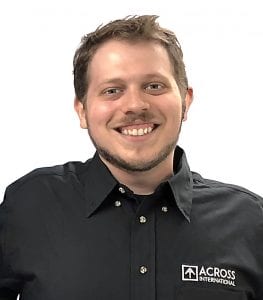
What’s a typical day like for you at Across International?
As sales development, I act as the intersection between the products our engineers design, our customers’ applications, and our staff getting the equipment into labs, factories, and workshops. For sales, that means conducting trainings and conference calls with end-users or distributors. For our management team, it means charting a course towards new R&D projects for new or current product lines, to prioritize them for our engineering department. I focus on our products’ specs, how they work, and applications they are used in.
A big part of Across International is trying to marry similar — and some different technology —under the same roof. A lot of universities, government agencies, and private companies tend to keep their sales with one knowledgeable sales rep who can help them build an entire lab or workstation. I make sure our salespeople inform the customer to ensure they make the right equipment decisions.
What does Across International bring to the heat-treat industry table?
We take advantage of lot of different types of technology in order to heat in a wide variety of temperature ranges at different rates. Generally, when you’re doing thermal processing, the No. 1 question is: How hot are you trying to get? We offer induction and molybdenum silicide or silicon carbide heating elements for high temperature applications. For low temperatures, we incorporate stainless steel chambers with standard resistance heating elements, and PT100 thermocouples in our ovens, rotary evaporators, and recirculating heaters.
As far as components, our philosophy is only the best. We work with Kanthal for 1,200 degrees C heating coil wire and 1,900 degrees C heating elements, in order to furnish our high-temperature furnaces with a reliable and durable heat source. Such heating elements provide greater temperature uniformity and a quicker heat-up time. We also work with Mitsubishi for the alumina ceramic insulation within the same vacuum tube and chamber furnaces. This is the highest-quality ceramic on the market, which provides greater temperature uniformity and a longer lifespan.
We consider induction heating one of our specialties. It’s a very specific field that not a lot of companies have knowledge in. We find ourselves often educating people — what’s the difference between, low, mid, and high-frequency? Customers do not come to Across International just because the equipment is in stock ready to ship, but because we understand our products and are happy to explain and answer questions for the researchers in the field.
What are some of Across International’s proudest achievements in the heat-treat industry?
Our proudest achievements surround offering solutions that improve customers’ day-to-day life — whether that be in ease-of-use, energy efficiency, or time savings. In one incident, we were invited to present to the lab managers at Oak Ridge National Lab ways induction heating could decrease heating times and energy consumption. This is one of the world’s most historic research meccas.
Our equipment in and of itself is on the front lines of cutting-edge technology. We’ve filled orders for NASA, SpaceX, and Tesla. We’re also helping to change the world in significant ways. Across has aided a nonprofit called the Billion Bottle Project, which seeks to eliminate water-borne diseases from our planet. These kill more children annually around the world than AIDS, TB, and malaria combined.
Where do you see the heat-treat industry in the next 10-20 years and Across International’s place in it?
I see more utilization of non-traditional heating techniques due to energy efficiencies. A lot of researchers we’re working with are interested in innovative energy storage methods. We must look at how we use energy. Our solid-state induction heaters, for example, have really impressed a lot of people on how much they can drive down electricity costs.
As far as vacuum ovens, we’ve found out that less is more as far as energy, but it’s just a matter of how you heat. For example, with vacuum ovens, the way to get a job done while using the least amount of energy is as quickly as possible. In our smaller vacuum oven chambers, heating the oven from all five walls (the door being the sixth) achieves the best uniformity and quickest time to temperature. This is challenging with larger vacuum ovens that cannot take advantage of convection — the most efficient heating method — to distribute heat.
For our large AccuTemp multi-zones, we have separate controllers to heat each rack independently, so we only spend energy on what’s on the rack – which is where operators keep their parts. The challenge this presents is the racks require welding to seal the wiring for the thermocouples and heating elements in each rack. But then what if you require removable racks for very large parts? Elite series ovens are a chamber-in-a-chamber that allow convection air to circulate through the heating elements and around the chamber, achieving a uniformity of 3 percent or better.
Developing heating solutions to get what the customer wants done, using as little energy as possible, is paramount among Across International’s goals as an industry leader in heat treatment equipment.
More information www.acrossinternational.com
























